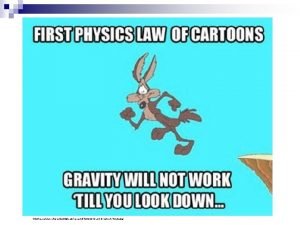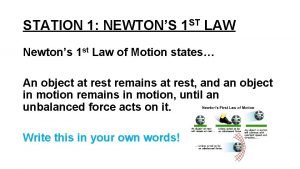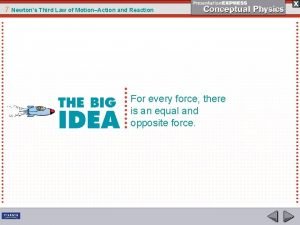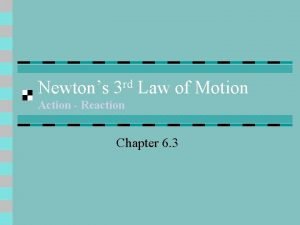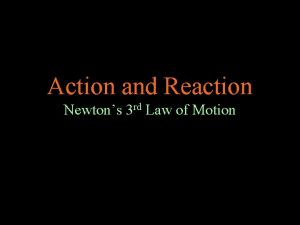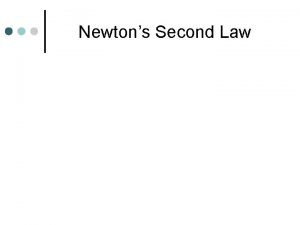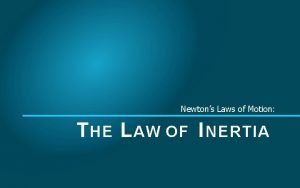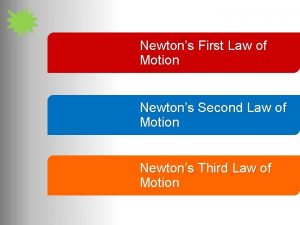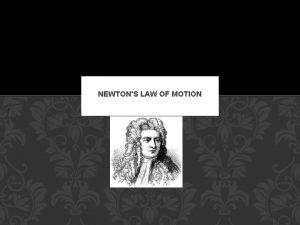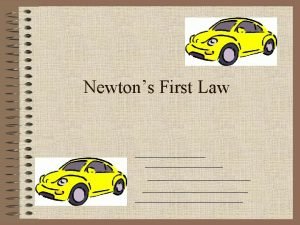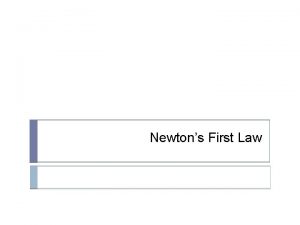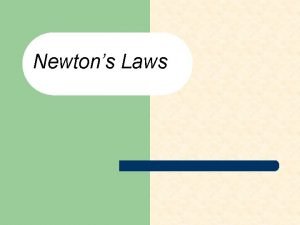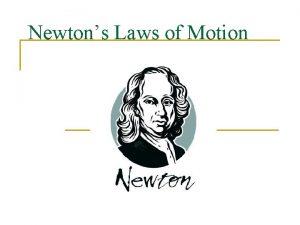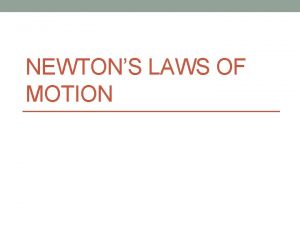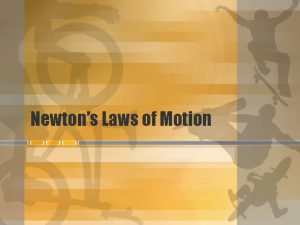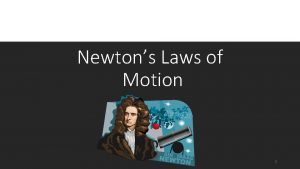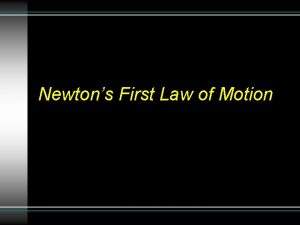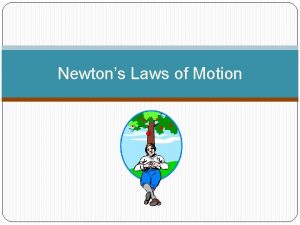Chapter 2 Newtons First Law of Motion Law

























- Slides: 25

Chapter 2 Newton’s First Law of Motion- Law of Inertia

2. 1 Aristotle’s classification of Motion A force is a push or pull

Aristotle Most famous scientist, philosopher and educator in ancient Greece. Classified motion into two types: natural and unnatural

2 Types of Motion Natural Motion: Directed up or down Objects have resting places Heavy objects fall faster than light objects Occurs without force Unnatural motion: requires forces

2. 2 Galileo’s Concept of inertia Disputed Aristotle that heavier objects fall faster than lighter objects. Disputed Aristotle that a force is required to keep an object moving.

2. 2 Galileo’s Concept of inertia Galileo said: A force was required to start an object moving No force was required to keep it moving except to overcome friction When friction is absent, a moving object does not need a force to keep moving

2. 2 Galileo’s Concept of inertia Inertia: the property of motion- the tendency of objects is to remain as they are (if they are moving, they remain moving; if they are at rest, they remain at rest)

Question • Distinguish between Aristotle and Galileos’ concepts of motion

2. 3 Galileo formulated the concepts of speed and velocity Speed: the distance covered per unit time speed= distance/time average speed: total distance divided by total time instantaneous speed: speed at any instant constant speed: movement at a fixed distance over time ratio (steady speed)

Speed • Speed = Distance/Time • Therefore: • Distance = ? • Time = ?

2. 3 Galileo formulated the concepts of speed and velocity Bowling Ball: 12 mi/hr = 20 km/hr = 6 m/s Tsunami: 50 mi/hr = 80 km/hr = 22 m/s Sprinting Cheetah: 62 mi/hr = 100 km/hr = 28 m/s

2. 3 Galileo formulated the concepts of speed and velocity Velocity: the speed of an object and the specific direction it is headed in vector quantity: a quantity that specifies direction as well as magnitude constant velocity: constant speed and constant direction

Question #1? What is the average speed of a cheetah that sprints 100 m in 4 s? 100 m / 4 s = 25 m/s

Question #2? ? The speedometer on a bicycle moving east reads 50 km/hr. It passes another bicycle moving west at 50 km/hr. Do both bikes have the same speed? Do they have the same velocity?

Question #3? ? ? • • A car is travelling at 75 km/hr for 3. 2 hours. How far does it travel? A runner is running at 9 km/hour and runs 15 km. How long is she running for?

2. 4 Motion is relative Everything is always moving You are moving relative to the sun and stars You are at rest relative to the Earth Motion is measured against a frame of reference (usually the surface of the Earth)

2. 4 Motion is relative When you are walking at a speed of 1 m/s down the aisle of a train, your speed relative to the floor of the train is 1 m/s. The floor of the train is your ______? _______.

2. 4 Motion is relative If you change your FRAME OF REFERENCE to the ground, your relative speed would change. HOW? ? ?

2. 4 Motion is relative Suppose the train is traveling at a speed of 50 m/s and it is traveling East. a. What would your speed be if you were also walking in a direction east down the aisle? b. What would your relative speed be if you were walking in a direction WEST down the aisle?

2. 5 Newton’s first law of motion- law of inertia Newton’s 1 st Law of Motion: Every object continues in a state of rest, or in a state of motion in a straight line at a constant speed, unless it is compelled to change that state by forces exerted upon it.

2. 6 Net Force/ 2. 8 support force Net Force (∑f) is the combination of all forces acting upon an object Measured in Newton (N) 1 Newton (1 N) is equal to the force required for a 1 kg object to accelerate 1 m/s

2. 6 Net Force/ 2. 8 support force Other Forces (also measured in Newtons) Normal or support force (FN) is the force that acts at a right angle to the surface (upward (+) or downward (-)) Frictional force (Ff) Tension force (Ft) is the force exerted by a string, cable, chain, or similar object on another object Force of gravity (g or Fw) ~ 9. 8 m/s

2. 7 Equilibrium for objects at rest All objects at rest are in equilibrium When the net force is zero, that object is in mechanical equilibrium Force Diagrams: show all forces acting on an object

2. 9 Equilibrium for moving objects Equilibrium is a state of no change Objects at rest are in static equilibrium Objects in motion are in dynamic equilibrium

2. 10 The earth moves around the sun We live on a moving Earth We do notice this because we are moving at the same speed If we flip a coin in the air while flying in an airplane, the coin will behave as if the airplane were at rest. In other words, the coin will keep-up with you!
 Newton's first law of motion meme
Newton's first law of motion meme Newton 1st law of motion
Newton 1st law of motion Newtons 3 rd law of motion
Newtons 3 rd law of motion Newtons 3 rd law of motion
Newtons 3 rd law of motion Chapter 8 ask newton
Chapter 8 ask newton Rd law
Rd law Newton's 3 laws of motion
Newton's 3 laws of motion Newton's third law
Newton's third law Newtons 3 rd law of motion
Newtons 3 rd law of motion Newton's 3 law
Newton's 3 law Newtons 3 rd law of motion
Newtons 3 rd law of motion Second law of motion
Second law of motion Neetons second law
Neetons second law Brainpop newton's laws of motion worksheet answer key
Brainpop newton's laws of motion worksheet answer key Newton's first law of motion
Newton's first law of motion What are the laws of motion
What are the laws of motion What is motion
What is motion Colin skateboards down the sidewalk
Colin skateboards down the sidewalk Newtons third lw
Newtons third lw The 3 law of motion
The 3 law of motion Newton's three laws
Newton's three laws Newton's first law and second law and third law
Newton's first law and second law and third law Newton's first law and second law and third law
Newton's first law and second law and third law Newtons first aw
Newtons first aw Chapter 2 section 1 describing motion answer key
Chapter 2 section 1 describing motion answer key Chapter 2 motion section 1 describing motion answer key
Chapter 2 motion section 1 describing motion answer key
